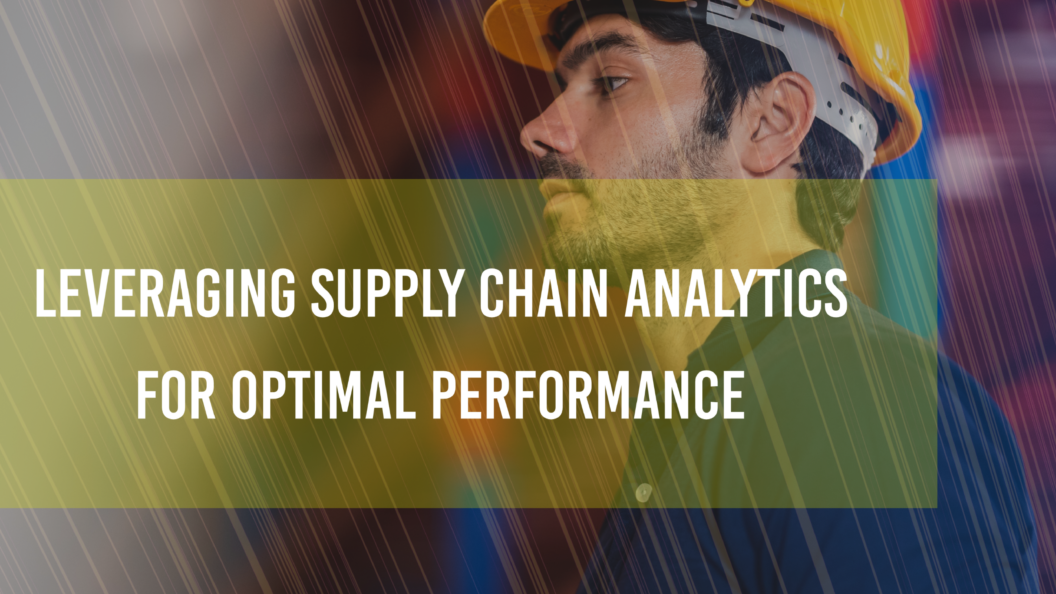Leveraging Supply Chain Analytics for Optimal Performance
Leveraging Supply Chain Analytics for Optimal Performance
Author: GDS
The goal of this blog post is to discuss the importance of supply chain analytics in driving optimal performance for businesses. It will explain what supply chain analytics is, how it can be used to improve various aspects of a business’s supply chain and offer some tips on using analytics effectively. The main takeaway from this post should be that businesses need to understand their data and use analytics to make informed decisions; without proper analytics, businesses risk inefficiencies that can lead to disastrous results. Ultimately, this post should give readers a better understanding of how supply chain analytics can be used to optimize performance.
The goal of this blog post is to discuss the importance of supply chain analytics in driving optimal performance for businesses. It will explain what supply chain analytics is, how it can be used to improve various aspects of a business’s supply chain and offer some tips on using analytics effectively. The main takeaway from this post should be that businesses need to understand their data and use analytics to make informed decisions; without proper analytics, businesses risk inefficiencies that can lead to disastrous results. Ultimately, this post should give readers a better understanding of how supply chain analytics can be used to optimize performance.
What Is Supply Chain Analytics?
Supply Chain Analytics is a process that provides businesses with an insight-driven approach to managing their supply chain operations. It involves collecting data from all aspects of the supply chain, then using analytical methods and tools to discover patterns and trends to optimize performance. By leveraging analytics, businesses can make better decisions about their production, inventory levels, pricing strategies, and more to improve efficiency, customer experiences, and profitability. With the right data-driven solutions, businesses can turn their supply chain into a competitive advantage.
What Is Supply Chain Analytics?
Supply Chain Analytics is a process that provides businesses with an insight-driven approach to managing their supply chain operations. It involves collecting data from all aspects of the supply chain, then using analytical methods and tools to discover patterns and trends to optimize performance. By leveraging analytics, businesses can make better decisions about their production, inventory levels, pricing strategies, and more to improve efficiency, customer experiences, and profitability. With the right data-driven solutions, businesses can turn their supply chain into a competitive advantage.
Why is it Crucial in Today's Business Environment?
In today’s fast-paced business environment, supply chain analytics is becoming increasingly essential for success. With the rise of global markets and ever-changing customer expectations, businesses are turning to data-driven solutions to gain an edge over their competitors. Supply chain analytics provides a way for businesses to make informed decisions about their operations and improve efficiency while providing an enhanced customer experience. With the insights gained from analytics, businesses can better manage their inventory and production levels, improve pricing strategies, identify potential risks, and more. This helps them to stay ahead of the competition while also achieving greater profitability. In addition, supply chain analytics also allows businesses to optimize operations by automating manual processes and streamlining procedures for increased efficiency.
Why is it Crucial in Today's Business Environment?
In today’s fast-paced business environment, supply chain analytics is becoming increasingly essential for success. With the rise of global markets and ever-changing customer expectations, businesses are turning to data-driven solutions to gain an edge over their competitors. Supply chain analytics provides a way for businesses to make informed decisions about their operations and improve efficiency while providing an enhanced customer experience. With the insights gained from analytics, businesses can better manage their inventory and production levels, improve pricing strategies, identify potential risks, and more. This helps them to stay ahead of the competition while also achieving greater profitability. In addition, supply chain analytics also allows businesses to optimize operations by automating manual processes and streamlining procedures for increased efficiency.
How Can Supply Chain Analytics Help?
Supply chain analytics can be used to identify opportunities for improvement throughout the supply chain. By understanding customer demand and supplier capabilities, businesses can better plan their production schedules and inventory levels. This helps them to meet customer expectations while avoiding overstock or out-of-stock situations. Supply chain analytics also helps businesses to monitor performance and detect potential risks in the supply chain, allowing them to make proactive decisions and avoid costly disruptions.
How Can Supply Chain Analytics Help?
Supply chain analytics can be used to identify opportunities for improvement throughout the supply chain. By understanding customer demand and supplier capabilities, businesses can better plan their production schedules and inventory levels. This helps them to meet customer expectations while avoiding overstock or out-of-stock situations. Supply chain analytics also helps businesses to monitor performance and detect potential risks in the supply chain, allowing them to make proactive decisions and avoid costly disruptions.
Enhance Customer Experience
The customer experience can be enhanced by supply chain analytics. By understanding customer demand and preferences, businesses can use analytics to create more personalized experiences for their customers. With a better understanding of the supply chain, businesses can ensure that customers have access to products when they need them and that orders are delivered quickly and accurately. This benefit is invaluable in today’s competitive marketplace, as customers expect a high level of service. By leveraging supply chain analytics, businesses can meet and exceed customer expectations.
Enhance Customer Experience
The customer experience can be enhanced by supply chain analytics. By understanding customer demand and preferences, businesses can use analytics to create more personalized experiences for their customers. With a better understanding of the supply chain, businesses can ensure that customers have access to products when they need them and that orders are delivered quickly and accurately. This benefit is invaluable in today’s competitive marketplace, as customers expect a high level of service. By leveraging supply chain analytics, businesses can meet and exceed customer expectations.
Tips for Making the Most Out of Supply Chain Analytics
1. Start with the basics: Understand customer demand and supplier capabilities to plan inventory levels and production schedules more accurately.
2. Automate processes where possible to optimize operations for greater efficiency.
3. Monitor performance closely to identify potential risks and take preventative action before experiencing costly disruptions.
4. Personalize the customer experience by using analytics to better understand customer preferences and needs.
5. Use analytics to identify opportunities for improvement to always stay one step ahead of the competition.
6. Take advantage of predictive analytics tools that can forecast future supply chain trends and allow businesses to adjust accordingly.
Tips for Making the Most Out of Supply Chain Analytics
1. Start with the basics: Understand customer demand and supplier capabilities to plan inventory levels and production schedules more accurately.
2. Automate processes where possible to optimize operations for greater efficiency.
3. Monitor performance closely to identify potential risks and take preventative action before experiencing costly disruptions.
4. Personalize the customer experience by using analytics to better understand customer preferences and needs.
5. Use analytics to identify opportunities for improvement to always stay one step ahead of the competition.
6. Take advantage of predictive analytics tools that can forecast future supply chain trends and allow businesses to adjust accordingly.
Identify and Collect Relevant Data
Analytics cannot provide valuable insights without the right data. Businesses must identify and collect relevant data from multiple sources to get a comprehensive view of their supply chain. This can include order history, inventory levels, customer feedback, supplier performance metrics, and transportation costs. Once the data is collected it needs to be properly organized into a format that analytics tools can read. Once in a usable format, the data can then be analyzed to uncover valuable insights.
Identify and Collect Relevant Data
Analytics cannot provide valuable insights without the right data. Businesses must identify and collect relevant data from multiple sources to get a comprehensive view of their supply chain. This can include order history, inventory levels, customer feedback, supplier performance metrics, and transportation costs. Once the data is collected it needs to be properly organized into a format that analytics tools can read. Once in a usable format, the data can then be analyzed to uncover valuable insights.
Track and Analyze Performance Metrics
Track and analyze performance metrics is an essential part of the supply chain analytics process. It helps businesses identify areas where they can improve their operations and also track how well they are doing. By monitoring key performance indicators (KPIs), such as delivery accuracy, cost per unit, lead time, inventory shrinkage, on-time delivery rate, order fill rate, etc., businesses can measure their performance against industry benchmark standards and adjust their strategies accordingly. These metrics help supply chain professionals make data-driven decisions and optimize their operations for maximum efficiency.
Track and Analyze Performance Metrics
Track and analyze performance metrics is an essential part of the supply chain analytics process. It helps businesses identify areas where they can improve their operations and also track how well they are doing. By monitoring key performance indicators (KPIs), such as delivery accuracy, cost per unit, lead time, inventory shrinkage, on-time delivery rate, order fill rate, etc., businesses can measure their performance against industry benchmark standards and adjust their strategies accordingly. These metrics help supply chain professionals make data-driven decisions and optimize their operations for maximum efficiency.
Implement Automated Processes to Streamline Operations
To further streamline supply chain processes, businesses can take advantage of automation. Automation eliminates human error and inefficiencies, allowing for faster and more accurate execution of tasks across all stages of the supply chain. Automated processes can also help reduce costs due to fewer manual tasks being completed by employees. Some examples of automated processes include order processing, inventory replenishment, warehouse management, and transportation planning. Automation can significantly reduce time-consuming tasks in the supply chain, allowing businesses to focus on more important tasks such as customer service or product development.
Implement Automated Processes to Streamline Operations
To further streamline supply chain processes, businesses can take advantage of automation. Automation eliminates human error and inefficiencies, allowing for faster and more accurate execution of tasks across all stages of the supply chain. Automated processes can also help reduce costs due to fewer manual tasks being completed by employees. Some examples of automated processes include order processing, inventory replenishment, warehouse management, and transportation planning. Automation can significantly reduce time-consuming tasks in the supply chain, allowing businesses to focus on more important tasks such as customer service or product development.
Conclusion
Supply chain analytics is essential for businesses to achieve optimal performance. It helps companies track and analyze performance metrics, identify areas where they can improve, and implement automated processes to streamline operations. As such, supply chain analytics provides invaluable insights that are essential for businesses to stay competitive in today’s market. By leveraging the power of supply chain analytics, businesses can maximize their efficiency, reduce costs, and deliver superior customer service. Thus, supply chain analytics is essential for any business that wants to succeed in a global market.
Conclusion
Supply chain analytics is essential for businesses to achieve optimal performance. It helps companies track and analyze performance metrics, identify areas where they can improve, and implement automated processes to streamline operations. As such, supply chain analytics provides invaluable insights that are essential for businesses to stay competitive in today’s market. By leveraging the power of supply chain analytics, businesses can maximize their efficiency, reduce costs, and deliver superior customer service. Thus, supply chain analytics is essential for any business that wants to succeed in a global market.
GDS ONSIGHT- A Field Service & Delivery Application
For businesses looking to optimize their supply chain operations, leveraging the power of supply chain analytics is essential. Contact us today to find out how our team of experts can help you maximize your efficiency and reduce costs with our comprehensive suite of SCM solutions.
GDS ONSIGHT- A Field Service & Delivery Application
For businesses looking to optimize their supply chain operations, leveraging the power of supply chain analytics is essential. Contact us today to find out how our team of experts can help you maximize your efficiency and reduce costs with our comprehensive suite of SCM solutions.








